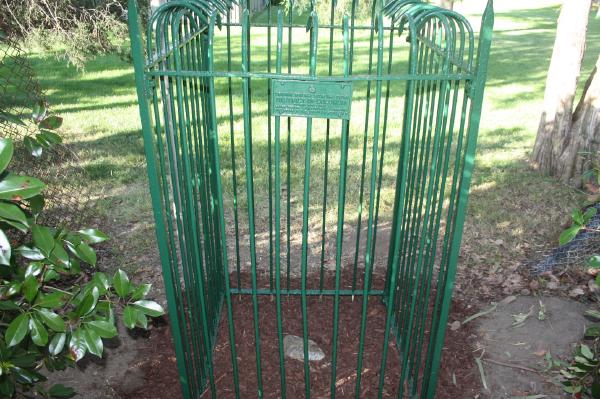This 75th Anniversary lookback article originally ran in the January 2018 edition of the All Fairlington Bulletin.
One of Fairlington’s significant historic assets is Boundary Stone Southwest #4, one of 40 milepost stones that mark the original District of Columbia. It is located on King St., between S. Wakefield St. and the entrance ramp to I-395, just outside the newly replaced Mews boundary fence. After many years of obscurity, shrouded in shrubs on the narrow shoulder of King St. and obscured by a chain link fence, the stone and its enclosure is now very accessible thanks to the gate conveniently placed in the new fence by the community-spirited Mews board.
The Stone was placed in 1791 by a party led by surveyor Andrew Ellicott. Ellicott’s description of the area at the time is a stark contrast to the current surroundings. “The country through which we are now cutting one of the ten-mile lines is very poor. I think for near seven miles, on it there is not one house that has any floor except the earth, and what is more strange it is in the neighborhood of Alexandria and Georgetown.”
In 1846, the entire southwest portion of the District—including most of the land on which Fairlington is located—was retroceded from the Federal City back to Virginia. The boundary stones remained in place, although, some—including our #4—were damaged or moved.
In 1915, the District chapter of the Daughters of the American Revolution (DAR) took on the task of preserving all of the stones. They erected protective iron cages around them, added explanatory plaques, and took on the long-term task of maintenance. Of these, 34 remain today.
Six years after Fairlington construction was completed, in 1949, the DAR historian reported that our #4 stone was in poor condition, “… broken off almost even with the ground.” In 1970, two years before Fairlington’s conversion to condominiums began, King St. was widened and the DAR noted that the stone had been buried, but was rescued and re-set 13 feet north of its original location (The Fairlington Boundary Stone, DAR, 2002).
For more on our Boundary Stone, go to the Boundary Stone page. For locations and descriptions of all 40 boundary stones, go to www.boundarystones.org.

Stump of Boundary Stone #4, 2012. Courtesy Guy Land